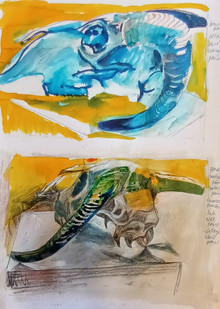LESSON PLANS SPRING TERM 2023 Lesson 1 - All angles of a still-life
- Clare Shepherd

- Mar 1, 2023
- 2 min read
Another week until classes begin again but I want you all to be ready! I may blog again (electricity allowing) but while I can, I wanted to get this lesson up online.
In this lesson I'm asking my students to set up a still life and make several drawings, sketches and studies of it from various different angles. You can use pen, pencil, colour pencil etc. These will become working drawings for later paintings - which will include mixed media and collage (but that's for next week. Here you can see I set a skull up in front of me and made loose sketches into which I then worked some watercolour and re-worked more pencil (all optional of course).
Spring Term 2023 lesson 1 Still Life: Looking from all angles. Making several studies of the various angles.
· Set up a still life of some (or one) objects on a cloth. Place the items on a cloth so that you can turn the cloth without touching the items.
· The idea is to be able to see the same set up from various angles.
· Choose your first view of the subject and make a loose pencil drawing, think about the following…
· i. Think about the shape of your page (square, landscape or portrait format).
· ii. Think about where you place the subject within the boundaries of your page. If your composition is very tall it might be good to place the highest point at the top of your page. This will give more room for any lower part of the composition to fit on your page.
· iii. Look for any shadows cast by the objects and add these into your composition.
· iv. Look for in-between shapes!
· Gradually add more information to your drawing – look for a variety of tones, hard edges and soft transitions. Identify your lightest places.
· Carefully turn your still-life around on its cloth without moving the position of the objects on the cloth.
· Make a drawing of the new view, use loose line and keep the drawing simple as you work out the shapes.
· Some of your drawings might remain very loose and some might become very detailed.
Next lesson: Keep these drawings safe! And bring them next week with (some or all) pencil, ink, emulsion paint, wax crayons, coloured pens/pencils, watercolours, torn paper (white and coloured), glue stick, anything you would like to add to the mix. You’re going to re-work all these drawings in a variety of ways, negotiating and re-negotiating their shapes, shadows and tones with some or all of the above.




















Comments